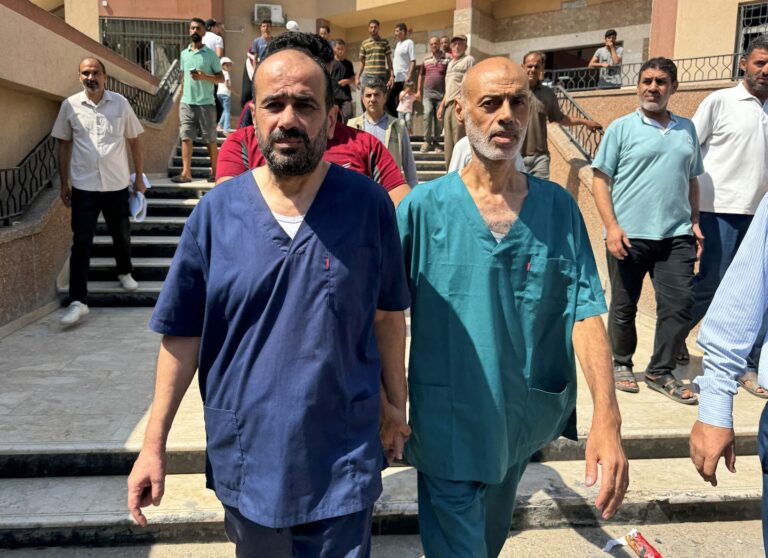Abu Salmiya was arrested in November after Israeli forces raided Gaza’s largest and most important hospital, accusing the medical director of allowing Hamas fighters to use it as a command and control center.
A subsequent analysis by The Washington Post found that the evidence presented by the Israeli government was insufficient to support the claim that the facility was actively used as a command center.
Abu Salmiya’s whereabouts have not been made public since his arrest. In a press conference after his return to Gaza, he said he was frequently tortured and denied access to a lawyer, Al-Quds Media Network reported. Israeli authorities did not issue a statement upon his release on Monday, and the army did not respond to a request for comment.
The attack on Al Shifa hospital has left it in disarray, with hundreds of sick and dying patients and thousands of displaced people targeted by a US ally in an unprecedented move in recent decades.
As Israeli forces closed in and fighting intensified, fuel ran out, supplies could not enter, and ambulances could not remove the wounded from the streets. The IDF claimed that five hospital buildings were directly linked to Hamas activities, and that the buildings were located above underground tunnels used by militants to direct rocket attacks and command fighters, and that the tunnels were accessible from inside the hospital.
Get caught up in
Stories to keep you up to date
Forces found weapons inside the facilities, but none of the five hospital buildings identified by the IDF spokesman appear to be connected to the tunnel network, and there was no evidence that the tunnels were accessible from within the hospital wards, according to a Post analysis of open source imagery, satellite imagery and publicly available IDF documents.
Abu Salmiya’s release angered Israeli officials, with National Security Minister Itamar Ben Gvir calling the decision a “security negligence” and Communications Minister Shlomo Karhi calling for the installation of “new security leadership.”
“Whoever made this decision lacked judgment and should be fired today,” said Benny Gantz, a former war cabinet minister who resigned last month.
Israeli Prime Minister Benjamin Netanyahu’s office said the decision to release the prisoners on Monday was taken independently by security services and that an “immediate investigation” had been ordered, and denied responsibility for the releases.
The Shin Bet, the domestic intelligence agency, blamed the releases on overcrowding in Israeli detention centres and said it had forcibly released prisoners who posed a “low threat”.
However, the country’s prison authorities disputed this account of the incident, saying that “the hospital director was not released due to a lack of detention space” and claiming that Abu Salmiya had been released from Nafha prison.
“Any allegations about failures in the release process undermine the professionalism and integrity of corrections officers who deal with the worst murderers every day,” the Bureau of Prisons said in a statement.
Meanwhile, unrest continues among ultra-Orthodox Jews in Israel over last week’s Supreme Court ruling allowing yeshiva students to serve in the Israeli army. Israeli police said protesters hurled stones at police on Sunday night, injuring several officers and leading to at least five arrests.
“We are not the same as the army. The army is Christian and European,” Shmuel Shitrit, 21, a student at the Jewish Theological Seminary in Jerusalem, said during the protest. “I believe it is written in the Torah that we should not serve in the army,” he said, adding, “The Torah will protect our country.”
At one point, protesters surrounded the car of an ultra-Orthodox pastor and hurled stones at it before police removed it, using skunk-scented water cannons and mounted troops to disperse the protesters.
Ultra-Orthodox parties have warned they will walk out of Netanyahu’s government if he fails to find a solution, risking the coalition’s collapse.
Other things to know
The IDF continues operations throughout the Gaza Strip, including in the Shejaiya neighborhood of Gaza City. The IDF said on Monday that its forces had carried out “dozens” of strikes and “discovered a large amount of weapons.” Residents of the densely populated area were ordered to evacuate last week as fighting intensified in Shejaiya.
About 20 shells were fired from the Khan Yunis area of Israel.The IDF said on Monday that some of the projectiles were intercepted, but some fell in southern Israel. “Israel Defense Forces artillery units are currently striking the source of the fire,” the military said. No injuries were reported.
At least 37,900 people have been killed and 87,060 injured in Gaza since the war began., The Gaza Health Ministry said most of the dead were women and children, although it did not distinguish between civilians and combatants. Israel estimates that about 1,200 people, including more than 300 soldiers, were killed in the October 7 Hamas attack, and that 316 of its soldiers have been killed since the start of its military operations in Gaza.
Heidi Levin and Lior Soroka contributed to this report.

